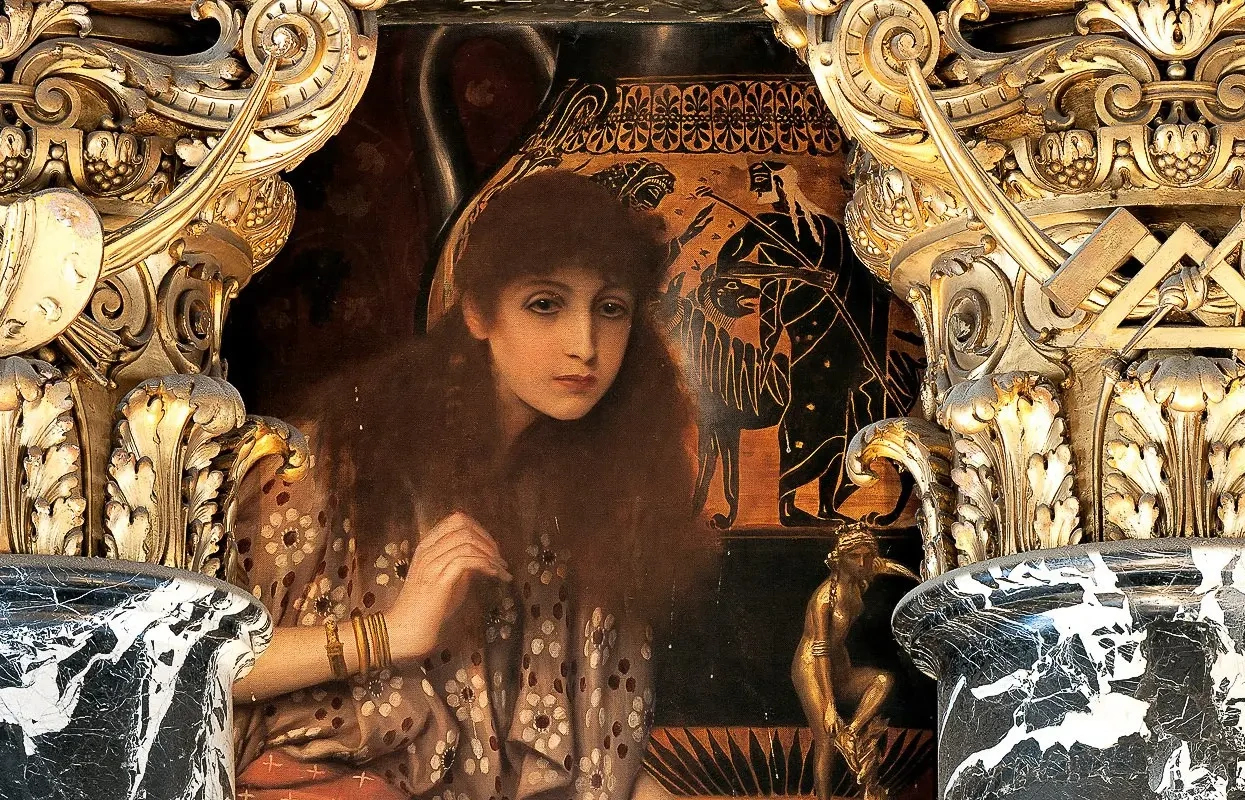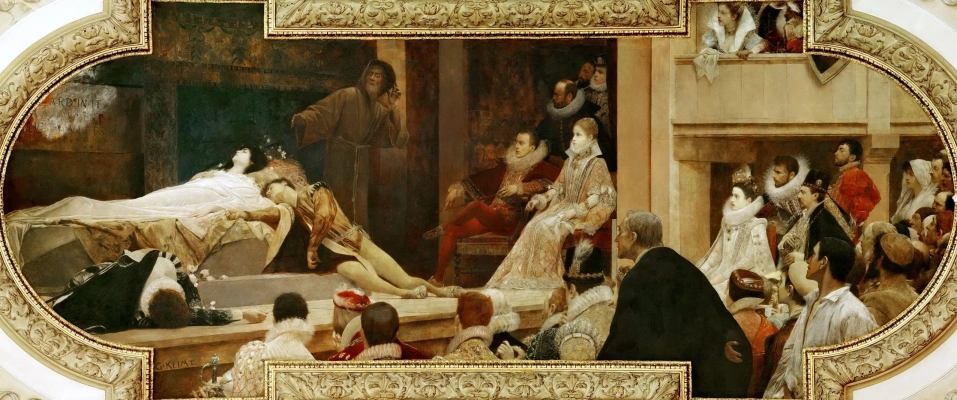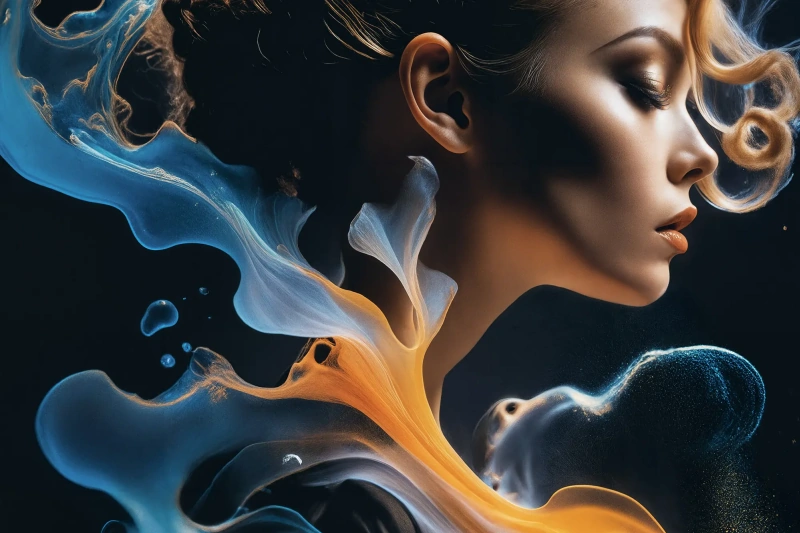The Vienna Museum of Art History has repeated its incredibly successful project, the rise to the paintings by Gustav Klimt. A temporary four tons podium, the Klimt-Bridge, allowed viewers to climb to as high as 12 meters to the arch scuncheons and the intercolumniations of the museum’s main staircase, where the artist placed allegorical images of the most significant epochs in the history of European painting.

Vienna is embroiled with "klimtomania". Gustav Klimt is the symbol of the Austrian capital along with Mozart. And a tourist, unwittingly infected with this virus, can no longer pass by the attraction, which repeats in four to five years at best.

For the first time, museum visitors were able to see the famous Klimt frescoes up close in 2012. Then the podium was erected in honour of the 150th anniversary of the artist’s birth. In 2018, the occasion was somewhat sadder: the 100th anniversary of his death.

A detail of the work by Gustav Klimt.
Today, it is hard to believe it, but some 150 years ago, there were no specially created museums in Vienna. The most valuable works of art were stored in private collections of noble Austrian families — not only the Habsburgs, but also the Liechtensteins, the Czernins, the Harrachs. If viewers were allowed to see these collections, it was done on preliminary written applications, and the access was available only a few hours a day.

Left: Museum of Art History. Photo source venagid.ru
On 20 December 1857, Emperor Franz Joseph I signed a decree according to which, the city walls around the old city centre were destroyed. A new European metropolis was born. Beside that, new museums were built. The architect Gottfried Semper was entrusted with the reconstruction of the Habsburgs city residence, the Hofburg. He created a Neo-Baroque project, which includes two museums (the Kunsthistorisches Museum (of Art History) and the Natural History Museum), a new theatre, an arena, a monument to the Austrian Empress Maria Theresa.

On the Klimt-Bridge.
The collection of the Habsburgs comprised the basis of the exposition of the Museum of Art History (by the way, it is available online now). On the first floor, there is a collection of decorative arts. The art gallery is located on the second floor in a series of large galleries with glass ceilings and a suite of small rooms.
At first, Hans Makart, a leading artist of the Ringstrasse epoch and a favourite of Viennese society, was ordered to decorate the staircase. He was asked to do "ceiling paintings and 12 lunettes on canvas, small spandrels and paintings for the spaces between the columns, on a gold background painted right on the wall." However, the artist died in 1884 and had not time to complete the work.
When Rudolf von Eitelberger, the director of the Austrian Museum of Art and Industry, introduced the artworks of young artists Gustav Klimt, his younger brother Ernst, Franz von Matsch to Karl von Gasnauer, the architect in charge of the design of the imperial museums, he exclaimed: "I will use you guys!".
At first, Hans Makart, a leading artist of the Ringstrasse epoch and a favourite of Viennese society, was ordered to decorate the staircase. He was asked to do "ceiling paintings and 12 lunettes on canvas, small spandrels and paintings for the spaces between the columns, on a gold background painted right on the wall." However, the artist died in 1884 and had not time to complete the work.
When Rudolf von Eitelberger, the director of the Austrian Museum of Art and Industry, introduced the artworks of young artists Gustav Klimt, his younger brother Ernst, Franz von Matsch to Karl von Gasnauer, the architect in charge of the design of the imperial museums, he exclaimed: "I will use you guys!".
By that time, the Company of Artists, as the trio called themselves, already had quite a wealth of experience in decorating public buildings. They designed curtains and ceiling paintings for theatres in Reichenberg, Hermesville, Carlsbad and Fiume. In the new building of the Vienna Burgtheater, in 1886—1888, the friends created ceiling frescoes and intercolumnar paintings, a mosaic panel. For the last work, the Emperor of Austria awarded Gustav Klimt with the Golden Order of Merit.
The Company of Artists got the most compositionally difficult and ungrateful part of decorating the stairs at the Kunsthistorisches Museum: they were ordered a total of forty paintings in an extremely unattractive place — more than twelve meters above the floor level in spandrels of high arcades and in the spaces between the double columns that separated them.

On 28 February 1890, the Hofbau Committee (Imperial Construction Committee), responsible for the expansion of the city, signed a contract with the three young craftsmen who promised to fulfil the order "together, that is, one for all and all for one" and "to justify the highest demands of art".
For their work, the Company of Artists was to receive a total of 14 thousand guilders. This was the highest pay for the artists who worked on the interior of the museum. Compare: in 1891, a middle-level civil servant earned 1,690 guilders a year. However, the high payment included the execution of sketches and paintings, selection of finished paintings, delivery of the canvas and transportation of finished paintings to the museum, as well as any necessary retouching after placing the paintings in their locations.
This project was challenging not only in technical aspect, but also because they only had five months to complete it: all paintings were to be completed and installed in their place by the end of July 1890.
The plots for 40 paintings to be created by the Company of Artists were selected by Albert Ilg, an outstanding art historian and curator of the museum. Wall painting was conceived as a series of thematic pictures of different artistic styles illustrating the history of the main European artistic centres, including ancient Greece and Rome, as well as ancient Egypt. The poses, costumes and individual objects had to accurately reflect the style and items typical of each period.
For their work, the Company of Artists was to receive a total of 14 thousand guilders. This was the highest pay for the artists who worked on the interior of the museum. Compare: in 1891, a middle-level civil servant earned 1,690 guilders a year. However, the high payment included the execution of sketches and paintings, selection of finished paintings, delivery of the canvas and transportation of finished paintings to the museum, as well as any necessary retouching after placing the paintings in their locations.
This project was challenging not only in technical aspect, but also because they only had five months to complete it: all paintings were to be completed and installed in their place by the end of July 1890.
The plots for 40 paintings to be created by the Company of Artists were selected by Albert Ilg, an outstanding art historian and curator of the museum. Wall painting was conceived as a series of thematic pictures of different artistic styles illustrating the history of the main European artistic centres, including ancient Greece and Rome, as well as ancient Egypt. The poses, costumes and individual objects had to accurately reflect the style and items typical of each period.

A detail of the work by Gustav Klimt
Each of the Klimt brothers and Franz von Matsch decorated one wall of the staircase; the fourth wall, the western one, was equally divided between them according to a lot. Thirteen of the forty paintings were made by 29-year-old Gustav.
All of them are the artworks located on the north wall (opposite the hall under the dome), as well as the paintings between the columns and in the arcade spandrels on the far left of the western wall (opposite the second courtyard). Sketches of almost all of his paintings have survived. Six of them are in the Museum of Art History now. Another one, painted for the space between the columns and dedicated to the art of ancient Egypt, is kept in the Vienna Museum.
The artists painted in their studio at the Sandwirt Lane in Vienna. The paintings were completed in 1891 and glued to the walls in April of the same year, six months before the museum was opened. To fix them, the technique of marouflage (French word for gluing) was used — canvases were glued to a bare wall or primed with a layer of oil blended lead white or rye paste. Usually this method was used for gluing large ceiling panels and decorative friezes.
All of them are the artworks located on the north wall (opposite the hall under the dome), as well as the paintings between the columns and in the arcade spandrels on the far left of the western wall (opposite the second courtyard). Sketches of almost all of his paintings have survived. Six of them are in the Museum of Art History now. Another one, painted for the space between the columns and dedicated to the art of ancient Egypt, is kept in the Vienna Museum.
The artists painted in their studio at the Sandwirt Lane in Vienna. The paintings were completed in 1891 and glued to the walls in April of the same year, six months before the museum was opened. To fix them, the technique of marouflage (French word for gluing) was used — canvases were glued to a bare wall or primed with a layer of oil blended lead white or rye paste. Usually this method was used for gluing large ceiling panels and decorative friezes.

General view of the frescoes in the museum (photo source — www.khm.at)
The frescoes by Gustav Klimt are signed "G.K." or "GUSTAV KLIMT".
In these works, for the first time, appeared the features that would become characteristic of the artist’s style: decorativeness, linearity, a tendency to ornamentation. And certainly, Klimt loved women, which was reflected in his work. They say that at first he painted a nude female figure in a picture, and then "dressed" her.

The Klimt frescoes at the Museum of Art History are often compared to female Byzantine icons. But is it possible to equate the faces of the humble saints on icons with the artist’s sensual models full of life? Lush forms, loose hair, luxurious clothes, carefully painted bodies and genitals — the heroines of Klimt’s works, appearing before the eyes of museum visitors, do not look vulgar. Later, this suppressed sensuality and vitality, which manifested itself in female images in frescoes, would be revealed in the portraits of Emilia Flöge and Adele Bloch-Bauer.
Early Italian painting (Trecento and Quattrocento period: 14th — early 15th century. Proto-Renaissance and early Renaissance). In the spandrels, the male and female figures face each other, their curved bodies follow the curve of the arch.
A young man holding a book turns to a woman dressed in a gold brocade dress with ornaments. She raised her right hand, trying to attract him. A bronze bust of Dante hovers above a winged putto with a halo holding a shield. This painting symbolizes the unity of literature and fine arts.
Early Italian painting (Trecento and Quattrocento period: 14th — early 15th century. Proto-Renaissance and early Renaissance). In the spandrels, the male and female figures face each other, their curved bodies follow the curve of the arch.
A young man holding a book turns to a woman dressed in a gold brocade dress with ornaments. She raised her right hand, trying to attract him. A bronze bust of Dante hovers above a winged putto with a halo holding a shield. This painting symbolizes the unity of literature and fine arts.
Ancient Egypt. On the left an absolutely naked woman is depicted holding an ankh in her right hand (the Egyptian cross, a symbol of life, a cult object and amulet). She is life-giving. Death lurks between the columns: burial artefacts dominated by a large multi-coloured wooden sarcophagus. As models for this fresco, Klimt used images of archaeological finds in a large atlas of ancient Egyptian art and civilization, published in 1877 in Paris, as well as a catalogue of the Egyptian museum in Cairo. In his essay on Gustav Klimt and Ancient Egyptian Art, Ernst Czerny argues that the combination of the place of origin (discovery) of these artefacts, the time of their creation and function reflect the geographical chronological order of ancient Egyptian art.

Ancient Greece. This work is a tribute to the sculptor Phidias. On the right, Klimt depicted Athena, the goddess of wisdom and war, who is the centrepiece of the composition. The mature goddess, fully aware of her beauty and wisdom, looks at the viewer. The artist combined two sculptures of Phidias, which have only come down to us in marble copies: Athena Promachos and Athena Parthenos.

The female figure in the space between the columns is known as "the Girl from Tanagra" (a model for the Girl was a figurine found at the excavations of the ancient city of Tanagra). The girl in the fresco leans forward, her head slightly turned towards the viewer. Interestingly, Klimt did not copy artefacts from the rich holdings of the imperial collection for background decorative objects. As a model, he used an Athenian black vase depicting Hades, which is now kept in the Vatican Museum.

Roman and Venetian Quattrocento. Since the Middle Ages, Ecclesia, the Church has usually been depicted as a female figure with a halo in a long cloak. Its attributes are a bowl, a goblet, a cross and a banner with a cross.
The Klimt’s Ecclesia is a young woman. The cloak, opulently embroidered with scenes from the life of Christ, does not even hint at the contours of her body, leaving only her face and thin arms open. Ecclesia’s symbols and attributes are the three-tiered papal tiara and the papal cross.
The Klimt’s Ecclesia is a young woman. The cloak, opulently embroidered with scenes from the life of Christ, does not even hint at the contours of her body, leaving only her face and thin arms open. Ecclesia’s symbols and attributes are the three-tiered papal tiara and the papal cross.

Venice on the fresco is symbolized by the Doge as a representative of the highest power. Similar to the papal tiara, his sign was a hat. His pose and dress are copied from the famous portrait of Doge Leonardo Loredan by Giovanni Bellini.

Cinquecento and Quattrocento in Florence. Klimt depicted Michelangelo's David and Botticelli's Venus as the main subjects in Florentine art.


…After the success with the museum design, in 1894, Klimt received an order to paint the ceiling of the University of Vienna. He had to paint three pictures. In 1900, Philosophy, Medicine and Jurisprudence were born. But society did not accept these works, considering them too frank, and therefore they were not exhibited at the university. It was Klimt’s last public order.
Written by Inna Kats.
Written by Inna Kats.

This is a reminder that the Klimt-Bridge project (Stairway to Klimt) in the Kunsthistorisches Museum completed its work on 2 September 2018. However, fans of the artist’s masterpieces always have the opportunity to view them through the Swarovski telescope.
Follow Arthive on Instagram
All photos in this publication (except those specially signed) — © KHM-Museumsverband, source — museum press materials.
We recommend reading
1 minParrot, «Embrace imperfection, because perfection is an elusive goal»: Interview with Irfan Ajvazi , 20241 minArtist Fred Bugs Biography1 minThe Paintings of John Wick Chapter 4: Decoding the Symbolism Behind the Paintings3 minA Closer Look at the Stunning Paintings in Coca-Cola's Latest Ad “Masterpiece”















